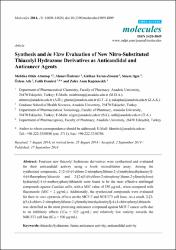Synthesis and in Vitro Evaluation of New Nitro-Substituted Thiazolyl Hydrazone Derivatives as Anticandidal and Anticancer Agents

Göster/
Erişim
info:eu-repo/semantics/openAccessTarih
2014Yazar
Altıntop, Mehlika DilekÖzdemir, Ahmet
Turan, Gülhan
Ilgın, Sinem
Atlı Eklioğlu, Özlem
Demirci, Fatih
Kaplancıklı, Zafer Asım
Üst veri
Tüm öğe kaydını gösterÖzet
Fourteen new thiazolyl hydrazone derivatives were synthesized and evaluated for their anticandidal activity using a broth microdilution assay. Among the synthesized compounds, 2-[2-((5-(4-chloro-2-nitrophenyl) furan-2-yl) methylene) hydrazinyl]-4-(4-fluorophenyl) thiazole and 2-[2-((5-(4-chloro-2-nitrophenyl) furan-2-yl) methylene) hydrazinyl]-4-(4-methoxyphenyl) thiazole were found to be the most effective antifungal compounds against Candida utilis, with a MIC value of 250 mu g/mL, when compared with fluconazole (MIC = 2 mu g/mL). Additionally, the synthesized compounds were evaluated for their in vitro cytotoxic effects on the MCF-7 and NIH/3T3 cell lines. As a result, 2-[2-((5-(4-chloro-2-nitrophenyl) furan-2-yl) methylene) hydrazinyl]-4-(4-chlorophenyl) thiazole was identified as the most promising anticancer compound against MCF-7 cancer cells due to its inhibitory effects (IC50 = 125 mu g/mL) and relatively low toxicity towards the NIH/3T3 cell line (IC50 > 500 mu g/mL).

















